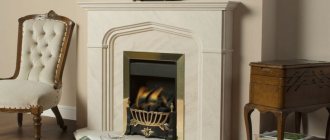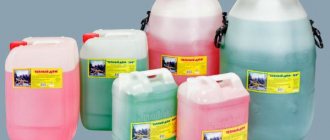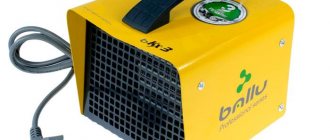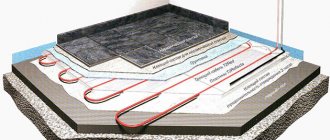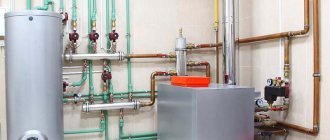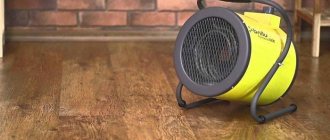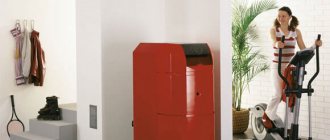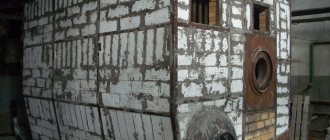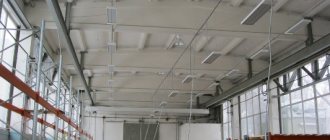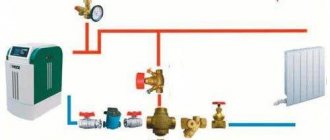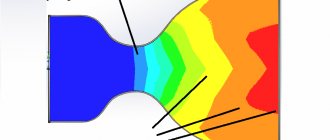Thermal curtains provide pleasant warm air in winter at the entrance to shopping centers, sports complexes, shops and other public facilities. The purpose of this equipment is to cut off cold air flows from the street. Various types of thermal curtains are installed at the entrance groups of objects in which frequent opening of doors is provided.
Very often, in shops, restaurants and warehouses, thermal curtains are installed at the entrance. Their task is to prevent cold air from outside from entering the room. An excellent option for ensuring a comfortable temperature in a building where doors are often opened.
Purpose of thermal curtains:
- In the cold season, the formation of drafts is prevented, which reduces the likelihood of illness among staff and visitors.
- Reduced heating costs.
- Protection of freezers and warehouses of refrigerated products from melting.
- Reduced heat loss.
- Protection from dust, insects and foreign odors.
- Minimizing energy consumption.
- In warm periods, reduction of air conditioning losses.
Manufacturers offer a large number of types of thermal curtains. To select the optimal option in terms of power and other parameters, it will be useful to familiarize yourself with the information presented in this review.
Types of curtains
All existing air curtains can be classified according to the type of installation and type of coolant.
By installation type
highlight:
- Horizontal curtains
. Installed above door and window openings. - Vertical
. The assembly is installed from the protected opening if installation from above is impossible or inconvenient. For retail, office and other commercial facilities, there are designer models in the form of a column. - Embedded
. The device body is completely hidden behind the suspended ceiling.
Based on the type of coolant,
all thermal curtains are divided into 3 groups:
- Electric models
. are very popular on the market and can be used in almost any environment: from small windows for dispensing goods, vestibules and doors to large industrial gates. The advantages are the availability of coolant, simple installation and convenient control, but the disadvantage is the cost of electricity consumed during operation. - Water curtains
are chosen if there is access to a heating or hot water system. They have high thermal power, significantly save energy, but are difficult to install. Professional selection of equipment is required, taking into account all the features of the system. Maintenance required. - Gas curtains
. require a gas supply and are used in large production facilities. They have high efficiency (almost 100% efficiency), high equipment cost and low ongoing operating costs compared to electric analogues.
What types of thermal curtains are there?
Depending on the direction of the air flow, there are 2 types of thermal curtains:
- horizontal;
- vertical;
- built-in (under-ceiling).
Vertical equipment is installed on the sides of the openings.
And the horizontal one is above it. In addition, there are special types of thermal curtains. An example of such devices is the splash-proof equipment that is included in car washes.
Based on the type of energy consumed, air curtains are divided into:
- electric thermal curtains;
- water thermal curtains;
- curtains without heating;
- gas thermal curtains.
Fan design and air-thermal curtain control system
Fans in thermal air curtains are designed in the form of a long impeller with a tangential operating principle. The fan motor can be located either on one side (at the end) or in the center of the impeller (divides the impeller into two separate elements). An indicator of the quality and reliability of an air heat curtain fan is the design and performance of the fan bearings. The air curtain control system is an electronic device that receives information from installed sensors and allows you to control work processes, including:
- heating temperature,
- air flow speed,
- air flow direction,
- work time periods,
- special operating modes (anti-freeze, etc.).
The air heat curtain control system also includes a system for indicating status and operating modes, which may include the ability to program the operation of the device.
The listed design features of the air heat curtain refer to electric models. The presence of another heat source requires the use of other systems, but the general principle of operation does not change.
Important characteristics of all types of curtains
All of the listed types of curtains are classified according to the following characteristics:
Power.
This characteristic affects the ability of climate control equipment to quickly warm up air masses that enter the room from the environment.
Calculation of power indicators when choosing thermal curtains is calculated according to the following algorithm: with a ceiling height ranging from 280 to 300 cm, 1 kW of power should be available per 10 m2 of room. This is a simplified method, but for a more accurate calculation of climate control equipment, it is necessary to use the help of qualified specialists from companies that sell/install thermal curtains.
Depending on power indicators and performance, there are 3 main types of thermal curtains:
- Household curtains can be installed not only on the openings of residential buildings. They are used for installation above cash register windows in kiosks and other MAFs. Such equipment reduces the likelihood of drafts and performs the functions of additional heating equipment for small rooms.
- Medium curtains are designed for openings with a height of 250 to 300 cm. They reduce heat loss when entrance doors are frequently opened and prevent drafts in large rooms.
- Large and heavy-duty devices are designed for industrial facilities with opening heights of more than 700 cm. They are installed on the openings of warehouse gates or hangars, at the entrances of supermarkets and shopping centers.
Operating mode.
Based on this parameter, there are 2 types of thermal curtains:
- permanent equipment;
- variable action systems.
According to the installation method, as noted above, thermal curtains can be horizontal or vertical, and in addition there is such a type of equipment as built-in thermal curtains.
- Horizontal air curtains are installed above window or door openings. In this case, climate control equipment is installed across the entire width of the opening in order to prevent the entry of outside air along the edges. This type of thermal curtains is the most popular, but in cases where there is no structural possibility for such installation, or for large openings, vertical devices with side placement are used. The installation technology of these types of curtains has minor differences.
- Vertical devices are installed on the sides of the openings so as to ensure the horizontal direction of the produced air flow. To increase the efficiency of climate control equipment, vertical thermal curtains are installed on both sides of the opening. Manufacturers' catalogs present universal curtains that can be mounted in vertical and horizontal positions.
Types of thermal curtains
When choosing a model, you should take into account the dimensions of your doorway. The width of the blown-out heat flow of the curtain should be wider than this indicator.
Next we will tell you what types of thermal curtains are. The most popular devices are horizontal. They are mounted above doorways and entrances and drive air from top to bottom. These are the ones we see in stores and shopping centers where there is a lot of foot traffic. The units differ in their size and performance, just like any other equipment.
Vertical thermal curtains are installed not on top of the doorway, but on its sides. There are two air flows here - one on the right and the other on the left. In terms of their efficiency, they are not much different from their horizontal counterparts, but they are more convenient for installation in rooms with low ceilings and high doors (when there is simply not enough free space above the doorways).
Evgeniy Filimonov
Ask a Question
Built-in thermal curtains are the least common, as they have a high price. They are built into ceilings and are distinguished by their invisibility. This is relevant in rooms with designer renovations, but in most cases, hiding them is not required. Therefore, they are quite rare on sale.
We can also highlight several other types of thermal curtains. But they are unlikely to be suitable for heating houses. Here is their list:
- Infrared - most often used in shopping centers and enterprises where it is necessary to prevent cold from entering the premises without creating excessive noise;
- Water - in some ways they resemble in-floor convectors with forced convection. They are distinguished by their increased power and high productivity;
- Gas - these thermal curtains operate on natural or liquefied gas, but they cannot be called safe (like any gas equipment).
Of all this, only infrared devices can be used at home.
Water thermal curtains are most often powered by heating systems - inside them there are radiators blown by fans through which coolant flows.
What are the differences between electric heat curtains?
Electric thermal curtains, as a rule, can be found at the entrance areas of hypermarkets and shopping centers. The doors of these objects open several times a minute, but at the same time, a reliable thermal barrier allows you to maintain a normal microclimate in the room even in frosty weather. It must be remembered that the main task that the installation of a thermal curtain solves is not additional heating of the internal air, but its cutting off from the external air masses. This ensures a normal indoor microclimate, despite any weather conditions.
Advantages of thermal electric curtains:
- equipment of this type is lightweight;
- simple installation;
- no risk of flooding or explosion hazard.
In addition to the advantages, this type of thermal curtains also has disadvantages:
- large volumes of electricity consumption;
- risks associated with the operation of electrical equipment that is energized.
Installing thermal electric curtains at the entrance group of public buildings allows you to reduce heating and air conditioning costs and ensure a stable indoor microclimate. The market offers a wide selection of climate control equipment of this type with different technical characteristics. As noted above, the main purpose of such equipment is to form a barrier that prevents the passage of street air into the room.
Thermal electric curtains in most cases have IP20 protection, which protects visitors from accidentally touching the equipment with their hand, turning off the device. In addition, emergency shutdown of the air curtain occurs when the equipment is overheated. Such protection is present in all types of electric curtains. Some manufacturers provide their models with moisture protection - IP54. Such devices are resistant to corrosion (their frame is made of stainless steel or galvanized steel) and can operate in conditions of high humidity. The design of electric thermal curtains includes a heating element that is powered by electric current. There are two types of such elements:
- STITCH is produced on the basis of wire or metal tape. Such elements heat up quickly and have low cost.
- The heating element heats up more slowly, but can produce a higher temperature. It is made from metal in the form of tubes of various shapes, on which a grille is attached, which increases the efficiency of thermal energy transfer.
Air heated by TENs or STITCH is accelerated by thermal fans in one direction, which allows you to create an air barrier that can be compared to a falling water flow. When choosing a thermal curtain of this type, you should pay attention to the presence of a tubular heater, which can provide higher performance. Another useful feature is remote control of the device. In addition, the heater must be separately regulated, which will allow the air curtain to be used in the summer.
Calculation of the thermal curtain
Let's talk about calculating a thermal curtain for a home. The main parameter is the height of its suspension - the required initial speed depends on it. The thing is that on the opposite side (near the floor, when installing equipment above the doors), the air flow speed should be 2-3 m/s. If this indicator is lower, then outside air will be able to penetrate into the room - the thermal curtain will only waste electricity. If the performance is too high, the heat will fly out.
At best, an incorrectly selected model may simply not give a positive result. And at worst, it can make the situation worse.
The initial speed directly depends on the working diameter of the fan. For example, with a diameter of 180 mm, the initial speed will be 15 m/sec. As for power, it all depends on the area of the room and performance.
The optimal performance indicator for a doorway with a width of 800-1000 mm and a height of 2000-2200 mm is from 700 to 900 cubic meters. m/hour, power – 6 kW (a little more is possible). For a more accurate calculation of all indicators, we recommend using online calculators.
What features do water thermal curtains have?
An effective equipment option for creating an air barrier in large openings is a water thermal curtain. The peculiarity of climate control devices of this type is low energy consumption. At the same time, installation of water thermal curtains requires significant financial costs, since they are connected to the water supply. To prevent freezing of the heater operating on water, these devices are equipped with modern control automation.
Advantages of installing water thermal curtains:
- more economical energy consumption compared to electric types of curtains;
- possibility of installation in openings whose width exceeds three meters;
- equipped with reliable automatic equipment that protects against overheating;
- convenient design and adaptive design;
- simple control of the direction of the heated air flow is provided by a rotating grille located next to the nozzle;
- low noise level during operation;
- effective prevention of the entry of external air flows, dust, insects, etc. through the open opening;
- protection against drafts in the room;
- high degree of corrosion protection and long service life.
Water thermal curtains have been used at various commercial and industrial facilities:
- factory floors;
- warehouse complexes;
- carriage depots;
- hangars;
- shopping and entertainment complexes;
- sports complexes and fitness centers;
- banking institutions.
This type of curtain also has its weaknesses:
- complex and expensive installation, which involves connecting to central heating;
- dependence on the proper operation of the water supply system (in the event of an accident in the heating and water supply systems, curtains of this type will not work).
CHARACTERISTICS OF THERMAL CURTAINS
Among the important parameters that buyers pay attention to when choosing equipment are the following:
- Performance. This is an indicator of the intensity of air exchange - how many cubic meters of air the installation pumps per hour. For a standard doorway of a residential building W*H 800*2000 mm, the average air curtain performance will be about 800 m3/h, and sufficient power is 6 kW.
- Power. With a ceiling height of up to 3 m per 10 m2 of room area, 1 kW of electrical energy is required.
- Noise. Shutters are noisy electrical appliances because the motors and fans run constantly to circulate air. The average sound level during operation is 50 dB. There are quieter models, but their cost is higher.
- Flow direction. Air can be supplied vertically downwards or to the sides - it depends on the type of installation. Horizontally oriented structures cannot be installed vertically, and vice versa. Incorrect installation will reduce the life of the working components of the thermal device.
- Temperature limits. On average, thermal cut-off devices are designed to operate at temperatures from -200C to +400C.
- The length of the body can be from 60 cm to 2 m. It must correspond to the width of the opening - this will avoid the appearance of dead zones in the protective barrier.
Water curtains.
In water thermal curtains, the heaters are not elements that convert electrical energy into heat, but central hot water supply or heating systems. Water shutters are successfully used on large doorways.
It is advisable to install them in workshops, warehouses or retail premises where it is necessary to combine heating functions with the prevention of drafts. Water installations do not use electricity for operation, therefore they are economical, while they are quite reliable and efficient.
Electric thermal curtains.
Electric thermal curtains are universal. They are often installed in private houses instead of the second entrance door in the vestibule; they are appropriate above an iron door, which condenses moisture in severe frosts. Electric curtains are widely used in production, warehouse, and trade structures.
There are two types of electrical cut-offs: single-phase ones operate from a 220V network, three-phase – 380V. They are available with different types of heating elements - spiral, strip (stitch) or heating elements. Several heating elements of different power can be installed in one device to provide two or more operating modes.
What are gas thermal curtains
Relatively recently, a new type of climate control equipment has appeared on the market - gas thermal curtains. In a fairly short time, they have become very popular for arranging facilities where there is no technical ability to connect other types of curtains. When choosing this equipment, one should take into account its explosion hazard and the fact that the gas has a suffocating effect, as it displaces oxygen from the air, therefore the operation of gas curtains must be carried out in strict compliance with safety regulations.
Advantages of thermal curtains using gas fuel:
- accessible and inexpensive energy carrier;
- efficient operation over a wide temperature range;
- no risk of system freezing;
- formation of a homogeneous air curtain;
- sufficiently high air flow density;
- equipment can operate on different types of gas fuel.
As noted above, the main disadvantage of climate control equipment is the high flammability of gas and its danger to human health. Unqualified connection of such curtains increases the likelihood of emergency situations.
Features of the thermal curtain
The thermal curtain is a long fan that creates a flat and powerful flow of warm air. Its main function is to create an invisible barrier to the penetration of cold air masses into the room. An air thermal curtain is like a closed door in those buildings where there is always a large flow of people and the door is constantly opening and closing.
Thermal curtains are especially important in restaurants, shops, passageways, lobbies of business centers, and subways. You can install a thermal curtain for your home, cottage, or garage.
As for the installation location - above the door or above the window. The curtain does not allow heat to disappear from the room when the front door is constantly open for a long period of time.
Thermal curtain without heating
For some facilities (freezers, refrigerated product warehouses, etc.) there is no need to install air curtains that form an air barrier from heated air. Here it would be appropriate to install climate control devices without a heat source. In addition, this type of curtain can be used to divide a large room into separate zones with specified temperature parameters. This need arises in large grocery supermarkets, agricultural produce storage facilities, etc. For their installation, technological openings are arranged, on which a dividing air curtain is attached horizontally or vertically from the outside.
A dense air flow into curtains of this type is created by a powerful high-speed fan. The installation of the separation curtain must be carried out in such a way that the separation air flow is directed at an angle away from the area in which it is necessary to ensure a stable microclimate. This solution will provide a reliable barrier against the penetration of air masses along the floor surface.
The device of the heating element of the air thermal curtain
The heating element of an air heat curtain is an electric heating element (or several heating elements), which are located along the body of the device. If there are several heating elements, most often they are placed side by side, and not one after another along the body, which ensures uniform heating of the entire air flow. The use of heating elements that use coolants (water, steam, etc.) classifies these devices as a special type. Therefore, it is believed that thermal air curtains are supplied exclusively with electric heating elements - heating elements. The heating elements used can have different designs:
- open spiral - the simplest and cheapest heating element,
- closed spiral - the spiral is placed in a housing with a filler, which can significantly extend the service life and eliminate some undesirable phenomena,
- special heating elements - ceramic and other heating elements that use special technologies to increase service life, improve operating efficiency, ensure safety or reduce electrical energy costs.
Heating elements in curtains
Spiral.
This type of heating element is made from metal wire.
In the past, spiral heating elements were used for almost all types of heaters. The development of technology leads to the gradual replacement of this design with more efficient and reliable heating elements. The most popular type of such elements for thermal curtains currently are heating elements.
The heating element is made in the form of a metal tube into which a nichrome thread or other element with increased heat transfer is sealed.
To increase the efficiency of heat generation, the metal tube is bent and equipped with gratings or other structural elements that increase the heat transfer area. Another type of heating elements that are installed in not very powerful thermal curtains is called STITCH.
STITCH is a needle heater that looks like metal plates. These parts are able to warm up quickly enough, but cannot maintain such high temperatures as heating elements. In addition, STICH is not reliable when connected to an electrical network, where voltage surges are possible.
The most modern version of heaters is ceramic elements. They are produced using PTC thermistors, which are highly reliable and allow for more economical energy consumption. Traditional types of heating elements constantly consume the same amount of electricity when turned on, according to the set temperature parameters. Ceramic elements consume the same amount of energy only during the heating period, after which they begin to operate in economical mode (the higher the heating temperature of PTC thermistors, the more economical their operation will be). The economic effect of installing thermal curtains with ceramic heaters can reach 40%. The disadvantage of this type of equipment is its high cost, but it must be taken into account that these costs are compensated by lower energy costs and a longer service life of the heating elements. For example, if heating elements last about 3 years, then ceramic heaters can work normally for 6 years.
Electric air curtains are the most popular on the market - they are the easiest to install and operate. The main disadvantage is high energy consumption.
Taking into account the length of winter in Krasnoyarsk, efficiency is of particular importance. Here we will look at the most economical thermal electric curtains operating on ceramic heating elements.
The fundamental difference between ceramic heat curtains and electric heating elements lies in the electric heating element itself - the first operates on PTC thermistors - semiconductor resistors with a positive temperature coefficient, the electrical resistance of which and, accordingly, power consumption depends primarily on the temperature of their surface.
The higher the PTC thermistor temperature, the lower its power consumption. You can read more about the advantages of PTC-based heaters compared to traditional heating elements in the article about ceramic heating elements.
Electric thermal curtains based on PTC elements allow you to:
1. Significantly reduce energy costs. The current consumption is the same at any temperature of the heated air and is equal to its maximum value, while when operating PTC elements, the maximum current is achieved only at low input temperatures and high air flow rates.
As operating experience in Krasnoyarsk has shown, the use of air curtains with ceramic heaters is guaranteed to provide 30-35% savings in electricity costs !
In addition, such curtains have a more organized air flow, which makes it possible to cut off cold air as efficiently as possible, practically eliminating the entry of warm air into the street and, accordingly, the heat loss that occurs in this case.
2. Significantly increase the period of continuous operation of the heaters and, accordingly, the period of trouble-free operation of the thermal curtain.
The indicator “number of operating hours between failures” on ceramic elements is 3-6 times higher than that of traditional curtains on heating elements!
In addition, in many of these devices, to increase the service life and prevent overheating of the heaters, the fan operates for two minutes after the device is turned off.
3. Ensure complete fire safety and the absence of any oxidative processes (oxygen combustion, carbon dioxide formation, release of specific odors of burning dust particles), which are often present on the surface of high-temperature heating elements.
Additional features:
1. Increased operating efficiency - the devices are manufactured using more modern technologies and have a high air flow, 1.5-2 times higher than similar indicators from other manufacturers. Therefore, with the same declared power in kW, such thermal curtains cut off the cold flow from the street much more effectively.
2. Ease of use - many curtains on ceramic heaters (in particular, DANTEX) can be installed not only horizontally, but also vertically. In addition, they have a very low noise level and two fan speeds.
Today in Krasnoyarsk there are two manufacturers: DANTEX and Teplomash. Most DANTEX models are made on the basis of R.T.S. elements. In addition, the well-known Teplomash plant in Krasnoyarsk also offers several models based on ceramic non-germing elements - in particular, the 100E series offers air curtains with a power of 2 to 20 kW for offices, includes models based on R.T.S. elements.
If we add up all these advantages, then we can confidently say that the slightly higher cost of curtains with ceramic heaters more than pays for itself in the first year of operation, especially taking into account the duration of the cold period in Krasnoyarsk, when the use of a thermal curtain is absolutely necessary.
The most economical thermal curtain is based on ceramic heaters!
Additional differences between thermal curtains
Different types of thermal curtains differ not only in the installation method, type of heating element or energy consumption, but also in other characteristics. The most commonly used classifications of curtain types are based on maximum width and operational features. The following criteria allow you to choose the best option for climate control equipment to solve different problems:
System control method.
Most air curtains are equipped with two switches (fan/heater). At the same time, you can find models that have:
- step regulators of power parameters and heating speed;
- built-in/remote control panels.
Another element that requires special consideration is a thermostat, which automatically turns on/off the heating element at certain temperature conditions inside the room. You can get acquainted with some aspects of choosing thermal curtains by watching the video.
Air intake location and supply temperature.
Depending on where the air enters the thermal curtain from, as well as its outlet temperature, the following types of equipment are distinguished:
- curtains that take air indoors, with or without heating function;
- thermal curtains that take air from the environment, with or without heating function.
Flow direction.
Depending on the direction of air flow, you can select the following types of devices:
- equipment with vertical air supply from bottom to top;
- equipment with vertical air supply from top to bottom;
- equipment with horizontal air supply in only one direction;
- equipment with horizontal air supply in two directions.
The length of the thermal curtain can be from 60 to 200 cm. For standard openings, different types of curtains with a length of 80 to 100 cm are used. The length of the equipment should be slightly greater than the width of the opening. For openings whose length exceeds 200 cm, a design of several thermal curtains is used, which are mounted without a gap between each other.
Jet protection type.
In manufacturers' catalogs you can find two types of thermal curtains based on the type of protection from outside air:
- The shutter type of air flow protection involves complete blocking of air from outside. Such curtains contribute to more economical heating of premises using stationary heating radiators;
- The mixing type of protection provides for partial intake of outside air, which, before being supplied inside the building, undergoes preparation in the form of cleaning and heating. This type of thermal curtains helps saturate the air in the room with oxygen.
Frameless types of thermal curtains.
At some facilities, a more rational option would be to install a pressure unit with a fan separately from the heater and distribution unit. This type of equipment is used for industrial premises with high dust content in indoor areas. Such curtains are called frameless. They are also installed at facilities that belong to a high class of fire and explosion hazard. In this case, the heater is located in a separate room, where there is no likelihood of contact with flammable substances. Using a powerful fan, the already heated air is supplied through a duct system under pressure to the distribution unit.
Splash-proof types of thermal curtains.
This type of equipment is used in car washes. In the category of splash-proof equipment, models are presented for both horizontal and vertical installation. The usual size of such curtains ranges from 300 to 500 centimeters, but, if necessary, it is possible to manufacture equipment with other parameters. They can be equipped with different types of equipment for monitoring and controlling air flow, as well as various means of protection (IP54 protection degree, which ensures safe operation in high humidity conditions, is mandatory). For the manufacture of splash-proof thermal curtains, galvanized or stainless steel is used.
Double-flow types of thermal curtains.
Another type of thermal curtains that can be found in the assortment of some manufacturers is called “double-flow”. The peculiarity of this equipment is the simultaneous formation of two air flows with different temperatures (one flow is warm, and the other is at room temperature). A stream of warm air is supplied closer to the room, and another stream is formed closer to the opening space. This feature of double-flow thermal curtains provides more powerful shielding, which ensures a high level of comfort even in very cold outdoor weather. To create 2 air flows, this type of curtain is equipped with two fans, and, therefore, the energy consumption of such a device increases 2 times, but at the same time 30% heat savings are achieved.
Pros and cons of a thermal curtain
To better understand what this technique is, it is recommended that you familiarize yourself with the existing advantages and disadvantages. The first include:
- There are models with different power, so you can purchase a device from 1-2 kW or more.
- The thermal curtain for the door is compact, while having good performance.
- The device protects the room from the penetration of dust, smoke, gases and insects from the street.
- The curtains, operating in the summer, act as a fan that protects from heat.
The thermal curtain also has a number of disadvantages that cannot be ignored:
- Equipment consumes a lot of electrical energy, but this is typical for all heating devices.
- When using high-performance devices, you need to be prepared for the fact that the fan is noisy.
- Heating elements burn oxygen, so to avoid headaches and other problems, you will have to regularly ventilate the room.
What is better: a thermal curtain or a convector?
Both devices are popular and have their pros and cons. A thermal curtain is considered a universal device, that is, it can be placed in different buildings, but a convector is more suitable for offices and residential premises. It is important to understand that a compact air-thermal curtain will protect against cold air, dust, and so on entering the room. The convector helps to quickly and evenly heat the air in the room.
What are the types of thermal curtains for the front door?
For small entrance doors, as a rule, household curtains powered by electricity are used. But, for different door designs, curtains with different types of configurations can be used.
Types of thermal curtains for revolving doors.
Thermal curtains for doors of this type are equipped with intelligent control automation and are characterized by high performance indicators. Depending on the size of the opening and the design of the entrance group, you can select thermal curtains of different lengths with casings of different colors. The thoughtful design of such equipment and the correctly selected shade allow you to create a single ensemble in which the curtain looks like one with the revolving door. This type of climate control equipment can be found at the entrance to shopping malls and other public facilities. Built-in automation controls the operation of the heat curtain, taking into account the intensity of the door structure (in maximum power mode, the device operates only when the door rotates, and if the door remains stationary and the set air temperature is reached, the electric heater is completely turned off). Such equipment is installed vertically, to the side of the opening.
Types of concealed installation thermal curtains (concealed installation curtains).
If the task is to preserve the design of the entrance group as much as possible, then hidden-mounted thermal curtains are used. They are installed in the space under the suspended ceiling structure so that only the grille through which the air flow is supplied remains visible. This type of thermal curtain works in automatic mode (when the door is opened, the equipment operates at maximum power, and when it is closed, it goes into sleep mode, which is selected depending on the temperature indicators. Hidden-mounted thermal curtains are installed horizontally.
How much will you save by connecting automation for thermal curtains?
Let us note right away that if a door or gate is supposed to be open all the time, it makes no sense to install automation on it. However, if the opening is open only part of the time, then with the help of automatic control of air curtains it is possible to save significant sums, paying off with this savings both the purchase of automation and the air curtains themselves. The importance of using automation to control thermal curtains is due to the high power of thermal curtains and, as a consequence, large bills for heating or electricity. which the air curtain can potentially consume. To describe the scale of possible savings when using automation that controls air curtains, a real object on which the air curtain is installed has sufficiently moderate electrical power.
Object in Moscow:
- Apartment building with 150 apartments
- The only entrance to the apartments
- More than 1000 door openings per day
- Opening width 0.9m
- Opening height 2.1m
Thermal curtain and control:
- Tropik-Line T309E10
- Curtain length 1m
- Maximum heating power 9kW
- Door position sensor
- Thermostat
- Standard control panel 3E or Automatic control unit A3E for 3 speeds and 3 heating modes
Off-season, outside temperature from +5ºC to 0ºC
Without automation
To create comfortable conditions at the entrance with a standard 3E remote control, in such weather it is enough to install:
- 1 airflow speed
- 1 heating level at 4.5 kW
- From +23ºС to +25ºС on the thermostat
How the veil will work:
When the set temperature is reached, the heating will turn off, but the air-heat curtain will continue to provide air flow. When the temperature is below the set temperature, the heating will turn on again. Thus, the operating mode of the curtain will be determined by the temperature in the vestibule, but with some delay associated with the thermal inertia of the working parts of the thermostat. It is worth noting that the operating mode of the curtain has nothing to do with the position of the door.
At the facility under consideration, the heating of the curtain is turned on from 45% to 60% of the entire time, and the average air temperature in the vestibule is 22ºС. Neglecting the engine power of approximately 0.1 kW, it is easy to calculate that the thermal curtain will consume 48.6-64.8 kWh per day.
Why you need to set the temperature on the thermostat high enough:
If you set it to +20ºС or lower, then the air heating will turn off earlier than necessary, and passing people will feel discomfort due to the high-speed air flow. Unfortunately, due to the thermal inertia of the thermostat, it is impossible to set the operating mode of the thermal curtain in such a way that both heating and air flow are turned off. In this case, the air-heat curtain may remain switched off when the door is open, which will allow cold air to enter the room and minimize the positive effect of the heat curtain.
With automatic
To create comfortable conditions at the entrance during the off-season, you need to program the following on the A3E automatic unit:
- Complete shutdown with door closed
- 1 airflow speed
- 1 heating level at 4.5 kW
- The position of the thermostat is not important
How the veil will work:
The curtain will turn on only when the door is opened at the set heating and speed. As soon as the door closes, the curtain will turn off completely. Thus, the operating mode of the curtain will be determined solely by the position of the door, regardless of the temperature of the thermostat.
The average door opening time is 5 seconds, that is, 5000 seconds of air curtain operation per day. The average temperature of the vestibule will be kept at a level from +15ºС to +17ºС, and the temperature of the air leaving the thermal curtain is approximately +24ºС, thanks to which people passing by will feel comfortable. Thus, if we neglect the engine power of 0.1 kW, the total electricity consumption per day will be 6.25 kWh.
Saving:
Considering that the length of the off-season in the Moscow climate zone is about 3 months per year, and automation allows you to save about 50 kWh per day. The cost of this amount of electricity is already several times higher than the cost of the automatic control unit and is comparable to the cost of a thermal curtain.
Annual savings for the off-season period alone will amount to 4,500 kWh, that is, about 83%, which in monetary terms is about 21,000 rubles.
Conditions of moderately low outside temperature from -10ºС to 0ºС
Without automation
To create comfortable conditions at the entrance with a standard 3E remote control, in such weather you need to install:
- 3 air flow speed
- Heating level 2 9kW
- From +23ºС to +25ºС on the thermostat
How the veil will work:
The operating diagram of the curtain when using a thermostat is the same for all seasons, so we will not consider it. Just as for the off-season period, connecting a thermostat according to the scheme of completely shutting off the air-heat curtain is not recommended. Note that it would be more rational than the above scheme to switch to half heating when the set temperature value is reached. But since the connection diagram of the thermostat itself is the same for all seasons and is selected when installing and connecting the heat curtain, the heating is always turned off completely by the thermostat. Thus, the thermostat, with the specified connection, mainly serves the purpose of protecting the air curtain from overheating, but due to the very high ceiling in this particular vestibule, it rarely operates during the cold season.
In moderately cold weather, the curtain will be turned on for heating about 95% of the time. Thus, the electricity consumption of the curtain will be approximately 205 kWh per day.
With automatic
To create comfortable conditions at the entrance for conditions of moderately low outside temperature, the following must be programmed on the A3E automatic unit:
- From +15ºС to +16ºС on the thermostat
For a closed door:
- 1 airflow speed
- 1 heating level at 4.5 kW
For an open door:
- 3 air flow speed
- Heating level 2 9kW
How the veil will work:
When the door opens, the air curtain will begin to operate at full power (maximum air flow rate and maximum air heating), then when the door closes, the air curtain will immediately continue to operate at reduced power, but only until the temperature in the vestibule reaches installed on the thermostat. After this, when the door is closed, the air curtain is completely switched off.
Taking the average opening time to be 8 seconds (in the cold season the door return mechanism operates more slowly), we obtain that the thermal curtain operates for 8000 seconds per day or 9.3% of the total time of the day, consuming a power of 9 kW. With the door closed, to obtain the total energy consumption, you need to multiply the heating power of the air curtain 4.5 kW by the total operating time of the air curtain. That is, this is the time with the door closed when the temperature of the vestibule is less than 15ºС. This time will depend on the exact outside temperature and other conditions such as wind speed and direction. For -5ºС outside temperature in calm conditions it will be about 6 hours. Thus, with the door closed, the total energy consumption per day will be about 27 kWh, and with the door open – 20 kWh.
Saving:
The total energy savings per day provided by the use of automation in the moderately cold period of the year will be about 150 kWh.
Considering the duration of this period of the year in the Moscow climate zone is about 2.5 months, we get a total saving of more than 11,000 kWh, approximately equal to 73% or 52,000 rubles.
We will not make the corresponding calculation for the cold period of the year with an average daily temperature of less than -10ºС, taking into account the significantly shorter time duration of this period than the two above.
Switching the unit from off-season mode to moderately low outside temperature mode requires flipping 5 push-button switches, which only takes a few seconds. You don't even need to reconfigure the thermostat.
Please note that at low outside temperatures (less than -10ºС ÷ -12ºС) for optimal energy saving, additional automatic switching and changing the position of the thermostat will be required.
Total savings:
In this article, we examined in detail how exactly energy savings occur when using automation on a relatively small doorway. Just one season of operation of the automation at this opening will pay for not only the cost of the automatic control unit, but also the air curtain itself.
Only during off-season periods and moderately low temperatures, automation will provide a total saving of more than 15,500 kWh, which will be about 75% or 73,000 rubles.
When using air curtains on large gates, savings can reach hundreds of thousands of rubles per opening per season.
TROPIK-LINE specialists are ready to answer your questions regarding possible schemes for using automation and the optimal placement of its components at facilities where the use of automatically controlled air curtains is expected.
Accessories Large selection of accessories and automation for air curtains, fan heaters and heat guns.
Go to catalog
What are the best types of thermal curtains for gates?
For large gate openings, water heat carriers are more often used. Their performance is affected by the temperature of the coolant (water) and the required intensity of heat transfer, therefore, to control the operation of equipment of this type, a piping unit is installed. Considering the fact that electricity is more expensive than heat, we can conclude that water equipment is more economical than electric equipment. Even despite complex and expensive installation, water curtains pay for themselves much faster. This point is especially important for arranging an air curtain in large openings of warehouse gates or hangars, since in these cases a large amount of thermal energy is required.
How does a thermal curtain work and why is it needed?
The job of a thermal curtain is to ensure the preservation of the room microclimate, regardless of external climatic conditions. In Russia, this is usually protection from the cold when opening doors. In hot countries, air curtains are installed to retain conditioned, cooled air. For hot countries, it is common to install curtains not only on doors, but also on windows. A pleasant thing is that insects can rarely overcome the air curtain.
Thermal curtain refers to climate control equipment. The principle of operation is quite simple - a powerful air flow is formed, preventing free heat exchange between the room and the outside world. Some devices are additionally equipped with air filters. Coarse filters are mainly used to capture dust and dirt particles. Other equipment and filtration systems are responsible for air conditioning in the room.
An additional advantage of using air curtains is the absence of drafts from open doors. No air exchange means no draft. For this reason, curtains are often installed in private houses and apartments.
Areas of application of thermal curtains
In rooms with a special climate - greenhouses, refrigerators, warehouses, scientific and industrial laboratories, the installation of a thermal curtain protects the microclimate from street dust, dirt and sudden temperature changes. Using an air curtain helps save energy that would be spent restoring normal temperatures and protects equipment or plants from temperature fluctuations.
Instead of an air cushion, Russia traditionally uses a vestibule - the space between two doors, a transition gateway between the outside world and the room. In conditions of a large flow of people, with the doors constantly opening, the effectiveness of the transition vestibule decreases.
Recently, there has been a tendency to connect thermal curtains in residential premises and small shops. Energy saving efficiency is quite high. An additional plus is the ability to abandon the vestibule and get more usable space. Thermal air curtains in combination with panoramic windows are especially relevant.
Thermal curtain - brief instructions for selection and use
It is necessary to decide on several parameters - the type of air curtain (with a heating element, with connection to central heating, air curtain without heating)
The simplest type is powered by electricity, without connection to the heating system.
It is necessary to determine the power and the need for additional functions - air conditioning, dust removal, the presence and type of air filters. At this stage, it is advisable to seek professional advice.
Then the fastening method is determined - top, side, hidden.
The heat curtain is controlled from the remote control. Additionally, some samples have redundant mechanical control. Modern air curtains can have additional smart functions and control via a smart home system and via a smartphone.
How to choose a thermal curtain
A thermal curtain is a simple and practical way to protect your home or any room from temperature fluctuations. The curtain keeps you warm in winter and cool in summer, protects from accidental dirt, dust, and drafts. The curtain forms a directed air flow that prevents free heat exchange.
The design of the thermal curtain necessarily includes a powerful fan, an air intake and a grille for uniform distribution of the outgoing air flow. The most economical models consume a minimum amount of energy and do not heat the air - they simply create an air flow that prevents the free flow of air between the room and the outside environment. In Russia, this type is practically not used due to the long cold period.
Advanced models can heat and cool the air depending on the time of year.
The most common models in Russia are equipped with special heater tubes (metal or ceramic, depending on the model); air passes through the heating element and greets visitors with a warm stream, preventing the cold from penetrating. The air does not come into direct contact with the heating coil and does not lose moisture. Electric thermal curtains are the most popular models due to their easy installation, connection, excellent performance and low price.
Thermal curtains with water heating. Quite a rare model due to the difficulty of coordinating the connection of the heater to the central heating system. Used in large shopping centers, swimming pools and other premises with a closed thermal circuit of the building. The connection diagram for a heat curtain with water heating is as follows - the water circuit is connected to the heating system, and the fan drives air through tubes filled with hot water. The system is economical to use and its maintenance is much cheaper than with electric heating. It is basically impossible to obtain approval for connecting this type of equipment in an apartment building. This method is only for cottages and individual buildings.
In industrial buildings, air curtains with gas and steam heating are used. Industrial refrigerators use cooling tubes with inert gases, like in refrigerators.
Mounting type and installation height
There are only three main types of installation:
The most common and convenient mounting method is directly above the door or above the window. Modern models are compact and fit well into the interior.
Side mount. The curtain is attached to the side of the passage or door. It is logical to use when there is a very large flow and a high level of environmental pollution (shopping centers, subways); in this case, the curtain not only forms thermal protection, but also does not allow dust and dirt to penetrate, blowing it out at the entrance. Also, side fastening is used in residential premises when top fastening is not possible (decor, structural features of the room)
Hidden installation. In some cases, hidden installation inside the opening is used. This is the most difficult type of installation; you need to take care of the correct air intake and hollow out a niche for the device.
Installation height
This parameter shows the power of air curtain formation. If the opening height is specified as 1 meter, this means you can install this equipment above the window. Only a light breeze will reach the windowsill. If you choose super powerful equipment, for example, the Hintek RM-1220-3D-Y electric curtain with an opening height of up to 3 meters, you can install it at the entrance to the Bolshoi Theater.
Be sure to pay attention to the height of the opening when choosing thermal curtains.
For the rest, be guided by your own tastes. It is advisable to give preference to new models with a controller for automatically turning off heating, with control panels or even with integration into a “smart home”. Additional power management can always be installed using smart plugs or power controllers. Automate your living and working environment for maximum comfort.
The best thermal curtains
Among domestic manufacturers, I would like to recommend the Teplomash company and in particular the 100 Optima KEV-8P1064E series and the special protected 200 Optima series. Thermal curtains from the Teplomash company are in demand all over the world. It is worth noting that Teplomash produces the most powerful equipment at the moment and cooperates with leading manufacturing, transport and trading companies.
Models in the mid-price range are produced on the consumer market - about 9-18 thousand rubles, economy class - from 2 to 6 thousand. The price of industrial models averages up to 100 thousand rubles. These are very good prices for thermal curtains.
Low price and high quality of products, reliability and relevance of versions ensure sales. At the moment, the Teplomash company is one of the 10 world leaders and is a leader in all sales positions in Russia.
Among the younger models of the Teplomash company, it is worth paying attention to the electric curtain Teplomash KEV-2P1122E Optima Micro, weight only 5 kg, opening width from 70 cm. One of the most stylish and compact models on the market. The price is about 3000 rubles.
Timberk products and the AERO series are in high demand in the economy sector. The most popular model is Timberk AERO I THC WS2 2.5M - opening height up to 2.5 meters, a simple device with excellent power. The disadvantages of the series include its cumbersomeness. But it works without interruption. The price of younger models is about 3-5 thousand.
In the average consumer sector, the second position is occupied by the Ballu company and its excellent thermal curtains Ballu BHC-L08-S05, which are not inferior to the products of the Teplomash company in all respects except price.
The current rating of companies is as follows:
1. Teplomash
2. Timberk
3. Ballu
4. Tropic
How to choose the right thermal curtain
A balanced approach to choosing a certain type of thermal curtains involves an accurate assessment of the required equipment power, taking into account climatic conditions, structural features of the building and ventilation system parameters. Even with the same opening area in buildings for different purposes, the required thermal curtain power will differ.
Video: How an air-thermal curtain works
Algorithm for selecting the desired type of thermal curtain:
- Determine exactly what function the equipment should perform (cutting off outside air, partially heating the room, etc.), and also determine the frequency and duration of opening the opening.
- Measure the distance that needs to be covered by the air “damper” (the curtain should not be shorter than the opening).
- Calculate the required flow length. The productivity of the equipment depends on the correct determination of this parameter. It should be taken into account that drafts reduce the effect of the thermal curtain.
- Check the permissible noise level of the equipment. For residential buildings, office premises or catering establishments, it is necessary to choose thermal curtains with minimal noise levels. Otherwise, situations will arise in which you will have to choose the minimum fan operating mode to the detriment of the quality of the indoor microclimate.
- Analyze the operating conditions. For objects with high humidity or excessive air pollution, it is necessary to select special types of thermal curtains.
- Explore equipment adjustments and control options. Newer models have remote control panels that can be used to effectively control fan speed and air flow temperature. This type of equipment has limit switches that turn on the climate control equipment when the doorway is open. At the same time, the effectiveness of limit switches in some cases will be questionable, so the curtain will turn on for literally 1 minute. If the gate opening is opened only for a short time, then there is no need to equip the thermal curtain with limit switches. In some models, other types of automation elements may be installed. Ask the seller for information about their functionality so as not to pay extra money for unnecessary equipment.
- Study the parameters of thermal equipment taking into account the type of energy consumed. For electric heat curtains, check the power supply voltage parameters and the permissible maximum power. The total load should not be higher than the established standards, as this may cause ignition of electrical wiring and equipment failure.
- Calculate the thermal power of climate control equipment. If it is necessary to ensure cut-off of outside air and additional heating of the room, then the thermal power should be calculated as follows: 1 kW of heat should be generated per 27 m3 of room volume. It should be taken into account that a thermal curtain cannot be considered a full-fledged heating device. They are used only as additional equipment, but at the same time, with the help of a thermal curtain you can quickly warm up the air in small rooms.
- If you do not plan to install a concealed curtain, pay attention to the design of the equipment. If you subsequently decide that the equipment does not fit into the concept of the entrance group and cover it with a casing or paint it, you may lose the warranty.
Installation of the thermal curtain is carried out from the inner (warm) side of the opening, as close to it as possible. In this case, the air curtain must cover the entire width of the opening. When installing a curtain between rooms inside a building, the pressure may be different on different sides of the opening. A ventilation system must be used to equalize pressures.
General principle of operation of an air heat curtain
An electric air heat curtain operates on the principle of a fan heater, providing special characteristics of the outgoing air flow. That is, through the inlet of the housing, cold air is taken in and directed through the air filter (if provided for by the design). After the filter, the air enters the fan impeller of the air-thermal curtain and acquires speed and direction. At the exit from the fan, the air flow is directed through the heating element, where it receives the required temperature. Heating of the flow occurs upon contact with the surface of the heating element, which is increased by installing additional ribs, partitions, gratings or a complex structure with a large surface area. After the heating element, the air flow passes through an outlet in which guide structures (blinds, blades, slot-like grilles, etc.) can be installed to provide shape, direction and structure. At each stage of the air flow in the air-thermal curtain, sensors of various designs can be installed to monitor the condition of the working elements and flow parameters.
How to install different types of thermal curtains step by step:
- The thermal curtain should be installed as close as possible to the opening, and the air flow should cover the entire opening.
- Installation of this type of climate control equipment is carried out indoors. Installation of the device outside the opening can only be carried out in cases where it is necessary to prevent defrosting of the freezer compartments.
- After installing the thermal curtain, you should adjust the ventilation and air conditioning systems so as to minimize their impact on the air flow blocking the opening.
Installation of different types of thermal curtains is carried out according to the following algorithm:
- Stage 1. Mark and drill mounting holes in the building structure near the opening.
- Stage 2. Install the mounting brackets on which the thermal curtain will subsequently be attached. The distance between the brackets should be about 60 cm. Important: When installing the air curtain, you must ensure that its mounting screws are exactly in the grooves of the brackets.
- Step 3: After checking that the mounting screws are placed correctly, they need to be tightened. The air curtain can be mounted on a suspension, but for this it is necessary to verify the position of the installation fasteners. For installation of equipment on special ceilings, you need to install mounting holes in the panels.
The type of installation of a thermal curtain is determined by the type of model and the characteristics of the room. Before starting installation work, you should read the manufacturer's instructions and other accompanying documentation.
Some recommendations for installing thermal curtains:
- The curtains are attached to structures made of concrete or brick using brackets that are supplied with the equipment. If you need to install such equipment in buildings that are built using frame technology, then it is necessary to provide for the placement of additional load-bearing structures that will not only withstand the weight of the device, but also dampen the vibrations it produces.
- The mounting brackets are installed at intervals of 50–60 cm, which may vary depending on the type and size of the curtain.
- Anchors or studs of the required size are used to secure mounting brackets to building structures. In this case, fasteners of a smaller diameter cannot be used.
- Before arranging the holes for attaching the thermal curtain, it is necessary to mark the wall in accordance with the location of the grooves in the mounting brackets. Inaccurate markings can significantly reduce the reliability of fastening the climate control equipment.
- To install equipment suspended, special hangers are used.
- It is recommended to use a torque wrench to check the tightness of the set screws. In this case, it is imperative to use engravers and washers.
- After all the screws are tightened, you need to check the quality of installation.
- To ensure reliable protection of wide openings, several thermal curtains must be secured in series to cover the entire width of the opening.
Design of thermal curtains
An air heat curtain is a device inside which there is an air heater and a fan. The principle of operation of the curtain is very simple: the fan sucks air into the housing, where it is heated in an air heater. Then, using a radial fan, the warm air is forced into the room at the desired angle and creates an air curtain, thereby reducing heat loss and improving comfortable conditions. By the way, the price of the curtain depends a lot on this fan, since it is the most expensive part of the device.
Such a seemingly simple design is easy to install, but it is better to install such equipment after familiarizing yourself with some rules and features, and reading an article on the installation of thermal curtains.
